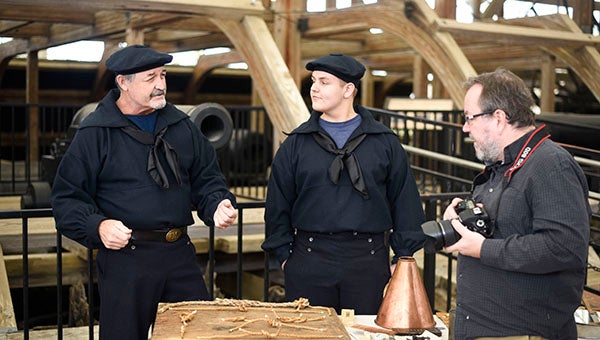Re-enactors bring Cairo history to live on 155th anniversary of its sinking
Published 5:19 pm Sunday, December 17, 2017

- Curtis Gordon, left, and TJ Burden portraying USS Cairo Navy Deckhands talk with Eric Pearson, from Burlington, Vt about the history of the USS Cairo Saturday. (Courtland Wells/The Vicksburg Post)
Blue jackets returned to the USS Cairo Saturday, as re-enactors participated in a living history exhibit at the boat’s museum at the Vicksburg National Military Park.
Park ranger Lela White, who was dressed as a crewmember of the Cairo, said the exhibit was in observance of the 155th anniversary of the ironclad gunboat’s sinking in the Yazoo River during the Civil War.
“We’re here to show people how the sailors lived on the Cairo and show what they did on board,” she said.
The exhibit displayed some of the items used by the sailors such as cups, plates, games they played while off duty and an exhibit of knots. The volunteer re-enactors demonstrated how the knots were made to visitors and described life on the boat.
The Cairo was one of seven ironclads called the “City Class,” because they were named after cities on the Ohio and Mississippi Rivers. It was part of the Union’s Mississippi River Squadron, the first “brown water navy,” and part of a Union plan to cut off supplies by blockading and capturing Confederate ports. The boat was crewed by 251 officers and men.
“The sailors worked six hours on and six hours off, and were constantly drilling,” White said.
“They had artillery drills, fire drills and abandon ship drills.”
She said most of the information about life on the Cairo came from the diary of George Yost, a 14-year-old cabin boy on the boat.
The sailors, she said, slept in hammocks shoulder-to-shoulder and did everything together.
“You had to know the men you worked with; how they did things, how they thought, so when a crisis came you knew how they would react. They worked as a team.”
The Cairo was sunk Dec. 12, 1862, almost 11 months after her Jan. 16 commissioning, while serving as part of a flotilla assigned to remove torpedoes (mines) from the Yazoo River in preparation for an assault on Vicksburg from the north by Gen. William Tecumseh Sherman.
Sharpshooters were on boats shooting out the fuses on the mines when they came under fire from Confederate snipers.
According to the story of her sinking, the Cairo’s captain, Lt. Cmdr. Thomas O. Selfridge Jr., believed he was under attack and began moving the Cairo forward when the boat struck two mines and went down in 36 feet of water in 12 minutes. All hands evacuated without losing a man.
The Cairo stayed in the silt at the bottom of the Yazoo until 1956, when it was found by Edwin Bearss, a VNMP historian, Max Don Jacks, a park employee, and Walter Grabau, a professional geologist using a pocket compass to detect the presence of iron and iron bar probes.
The Cairo’s pilothouse was the first piece of the boat to be raised in 1960. Later, the boat’s cook stove and cannon were removed.
When attempts to bring the boat up in one piece failed, the decision was made to bring her up in three pieces. That was accomplished Dec. 14, 1964, 102 years after her sinking.






